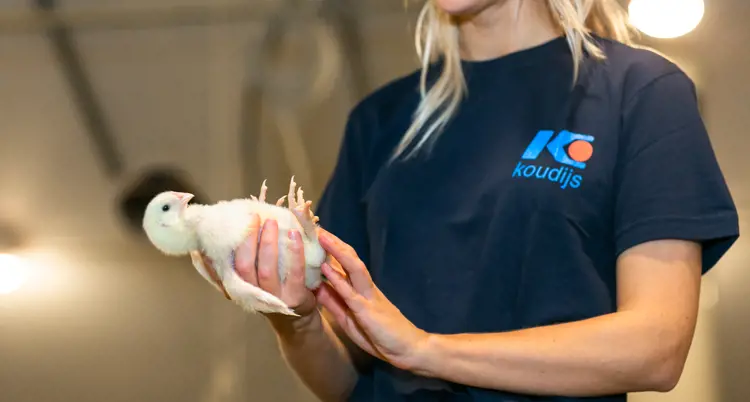The fatter the better in broiler breeding?
Broilers are genetically selected for high muscle tissue growth and low body fat. Over the past 30 years, the body fat mass in broiler breeder hens has decreased by approximately 50%. Several studies* have suggested that the body fat mass of broiler breeder hens plays an important role in sexual maturation, egg production, egg composition, and laying persistency. So, could there be a benefit to feeding above the standard growth curves and/or changing the energy/protein ratio in the diets? And what would be the subsequent influence on the performance of day-old chicks?

To answer these questions, our global poultry R&D department, together with Wageningen University, initiated a unique and comprehensive scientific research project in early 2019. This project is unique because it studies the entire lifecycle of the breeders, from day 1 in rearing until 60 weeks of age. By doing so, we aim to improve not only broiler breeder production but also the efficiency of commercial broiler chick production. In this article, we will focus on the results concerning the breeders.
Setup of the experiment
This first experiment involved 1536 Ross 308 female breeders, starting from 1 day old. The setup followed a 2 by 4 factorial design, with two growth curves: the standard breeding guide growth curve (SGC) and an Elevated Growth Curve (EGC) to achieve bodyweights 15% above the breeding target. Within each growth curve, four different diets were fed, varying in energy (AME) to protein ratios: 96% energy, 100% standard energy, 104%, and 108% AME. Protein and SID amino acids were kept consistent across the diets. Energy levels were adjusted by modifying fat, fine ground oat hulls, and starch to maintain consistent starch and fat ratios across the diets. Each treatment had three replicates, with 64 birds in each pen. All diets were fed in mash form, and birds followed a six-phase feeding program (0-3 weeks, 3-6 weeks, 6-16 weeks, 16-23 weeks, 23-40 weeks, and 40-60 weeks). During the first two weeks, feed was provided ad libitum, and then the treatments commenced. The trial setup aimed to create differences in both growth curves and body composition within each growth curve.
Results
In Table 1 the results are shown of the different growth curves and diets per phase on feed-, energy and protein intake. The goal of a 15% weight difference was reached at the end of rearing (2,60kg vs 2,95kg) and kept till week 60. Within the different growth curves, no statistical weight differences were present at 60 weeks for the different diets, so the data is not shown.
Table 1. Overview feed allocation, kcal- and protein intake per growth curve and average per diet.
It is clear that feed allowance needed to be reduced in diets with higher energy-to-protein ratios to maintain the same body weight. This leads to small differences in energy intake (2% during rearing up to 4% in weeks 40-60) but much higher differences in protein intake (11% during rearing up to 18% in weeks 40-60) for the different diets.
So, the birds did receive different amounts of nutrients, but does this affect body composition and technical results? An analysis of the abdominal fat pad showed that birds on the EGC had a higher percentage of fat pad compared to SGC (1.7% vs. 1.5% at the onset of lay and 2.3% vs. 1.7% at week 60). This difference was significant for most weeks and consistently present throughout each period. Additionally, diet composition significantly affected body composition at the onset of lay. The higher the energy/protein ratio, the higher the fat pad (from 1.1% at 96% AME to 2.0% at 108% AME). However, these differences disappeared after 46 weeks of age. Table 2 presents important production parameters.
Table 2. Overview of main production parameters of the breeders on the 2 different growth curves and 4 diets
From the results, it is clear that birds on the EGC come into production earlier and produce a higher number of heavier eggs. However, there is no difference in the number of settable eggs during the overall production period (22-60 weeks). Additionally, breeders with a lower energy-to-protein ratio come into production earlier and produce significantly more heavier and settable eggs in the first 20 weeks of production. However, this advantage is not present at the end of the laying period. Mortality was not affected by either the growth curve or the diet and averaged 8.4%.
This research was conducted as part of the PhD project of Jesse Heijmans, poultry researcher, in collaboration with Wageningen University, the Netherlands
Conclusions
Body weight can be influenced by the amount of feed given to the birds. It is also evident that birds on different diets can maintain the same body weight if the amount of feed is adjusted for gain. This suggests that energy is the most limiting factor for growth. There is no difference between growth curves in terms of the total number of settable eggs, nor among the different diets. Therefore, despite the differences in fat pad percentage in the body, no differences were observed in technical production parameters. Based on these results in the breeders, it is not necessary to increase feed quantity to achieve higher body weight at any stage of production.
In the next article, we will examine whether there was an impact on egg composition, the quality of their offspring at hatching, and the subsequent technical performance and carcass parameters of the broilers.
This research was conducted as part of the PhD project of Jesse Heijmans, poultry researcher, in collaboration with Wageningen University, the Netherlands. The findings from the research conducted in our R&D facilities are published in the Journal of Poultry Science as peer-reviewed articles.
Visit the Poultry Science website to read the scientific articles in more detail.

